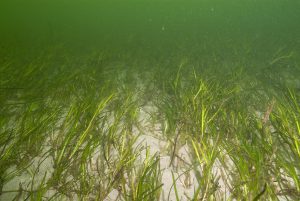: Seagrass Ecosystems in Taylor County, Florida
 Beneath the tranquil waters along the Gulf Coast of Taylor County lies a hidden gem crucial to the marine ecosystem—seagrass. These verdant underwater meadows play a pivotal role in the health of coastal environments, providing a multitude of benefits, environmental services, and serving as habitats for an array of marine life.
Beneath the tranquil waters along the Gulf Coast of Taylor County lies a hidden gem crucial to the marine ecosystem—seagrass. These verdant underwater meadows play a pivotal role in the health of coastal environments, providing a multitude of benefits, environmental services, and serving as habitats for an array of marine life.
Seagrass meadows, characterized by lush, flowering plants, act as critical nurseries and habitats for a diverse array of marine organisms. They offer shelter, breeding grounds, and a vital food source for important sportfish, crustaceans, sea turtles, manatees, and numerous other marine species, contributing significantly to the region’s biodiversity.
These underwater meadows perform a host of invaluable environmental services, like Carbon Sequestration, Erosion Control, and Water Filtration, among many others.
Seagrass beds are efficient carbon sinks. They play a vital role in mitigating climate change by absorbing carbon dioxide from the atmosphere. Their dense root systems stabilize sediments, reducing coastal erosion and protecting shorelines from the impact of waves and currents. Seagrasses filter water, improving water quality by trapping sediments and absorbing excess nutrients, thus promoting clearer waters.
Despite their ecological importance, seagrass meadows face numerous threats, including:
- Coastal Development
- Pollution · Boat Traffic and Anchoring
 Urbanization and coastal development can lead to habitat loss and water quality degradation, impacting seagrass beds. Runoff from agricultural activities, urban areas, and improper waste disposal can introduce pollutants and nutrients, leading to seagrass decline. Improper boating practices, such as propeller damage and anchoring, can physically harm seagrass beds.
Urbanization and coastal development can lead to habitat loss and water quality degradation, impacting seagrass beds. Runoff from agricultural activities, urban areas, and improper waste disposal can introduce pollutants and nutrients, leading to seagrass decline. Improper boating practices, such as propeller damage and anchoring, can physically harm seagrass beds.
In Taylor County, conservation groups, local authorities, and environmental organizations are actively engaged in preserving seagrass ecosystems by establishing protected areas and implementing regulations to safeguard seagrass beds from damage and exploitation, as well as undertaking seagrass assessment projects, that might lead to future habitat enhancement, and erosion control measures. Finally, by raising awareness and involving local communities in seagrass conservation through educational programs, volunteer efforts, and outreach initiatives.
Preserving seagrass ecosystems in Taylor County requires a collective effort. It necessitates the engagement of policymakers, community members, and stakeholders to ensure the long-term viability of these vital marine habitats.
Looking Ahead: Protecting a Marine Legacy
As stewards of our coastal environments, safeguarding seagrass ecosystems in Taylor County is paramount. By fostering a deeper understanding of their importance, implementing sustainable practices, and actively participating in conservation initiatives, we can ensure the preservation of these underwater wonders for generations to come.
In conclusion, the lush seagrass meadows of Taylor County serve as a testament to the delicate balance between human activity and nature’s resilience. They underscore the significance of our commitment to preserving and protecting these invaluable marine ecosystems.
 0
0
